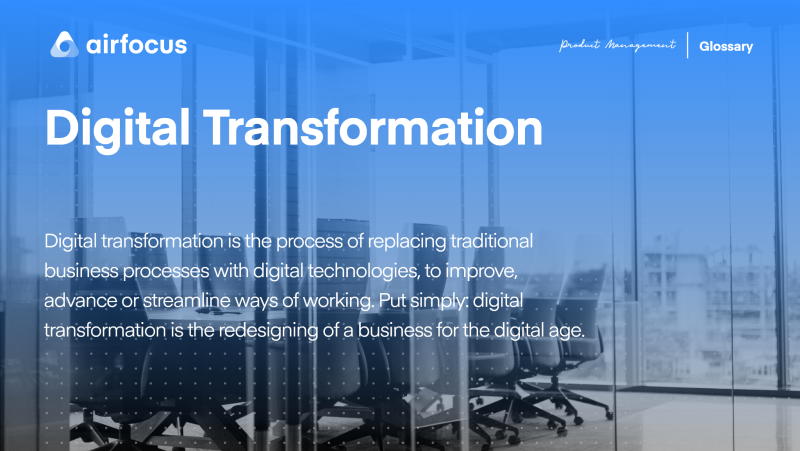Digital Transformation
What is digital transformation?
Definition of digital transformation
Digital transformation is the process of replacing traditional business processes with digital technologies, to improve, advance or streamline ways of working. Put simply: digital transformation is the redesigning of business for the digital age.
The aim of digital transformation is to make organizations:
More efficient and convenient for customers
Better able to scale as market conditions change
More responsive to customer needs
When done right, digital transformation dramatically improves how companies serve customers. But it’s not easy — the failure rate for digital transformations is high.
What is digital transformation used for?
Since the term was first coined in 2012, digital transformation has become a universal phenomenon where businesses use data, devices, and software to update how they operate, manufacture, and market products and services.
Digital transformation initiatives often begin as singular projects to improve services, by analyzing data to understand customer preferences and improve their experiences.
This could be a bank investing in mobile banking, or an energy provider taking a customer’s account online to empower customers to control their tariff and energy use from their own home.
But digital transformation isn't about minor or incremental improvements.
Rather, it radically alters how an organization’s end-to-end operations with new, more modern, methodologies. In many organizations, digital transformation is now seen as an ongoing process that continuously evolves with changes in technology.
Once a business has made the decision to undergo digital transformation, the scale and scope of the initiative creates opportunities to create new SaaS solutions that support the digital operations and workflow. Many businesses can’t do this themselves and will partner with digital transformation consultants to make the process as smooth as possible.
What are the benefits of digital transformation?
Digital transformation has the potential to unleash a company’s productivity and connect its output to changes in customer behavior or evolving market conditions, making it more competitive and future-proofed. Here are some of the primary benefits of digital transformation.
Digital transformation makes businesses drastically more efficient. Every time-consuming and error-prone manual activity that’s automated cuts countless hours of resources, allowing businesses to focus on more business-critical tasks.
The move to digital also frees up time for creativity and innovation while reducing operational costs.
In data-rich businesses, adopting the latest digital technologies can help identify market opportunities that would otherwise have been invisible
Organizations across industries can revolutionize how they create products, deliver services, and improve customer support
Customers benefit from more streamlined and convenient online interactions
What are the drawbacks of digital transformation?
Digital transformations require time, resources and funding.
For example, when undergoing digital transformation, an organization will need to move from analog to digital data storage — a significant internal project that requires a revised data protection approach and up-to-date digital security measures.
Changes in the way an organization operates can generate resistance internally — doing away with established processes can alter or eliminate job roles, and devalue certain skill sets.
What’s more, customers can resist change too.
This makes some businesses hesitant or fearful about embracing digital transformation and the technologies facilitating it.
Digital transformation is, at its very core, problematic as it presumes that users have access to technologies that are typically only widespread in developed, affluent societies. While it may feel that everyone now owns a smartphone, almost two-thirds of people around the world don’t. It’s therefore critical to ensure that no-one is left behind as services are increasingly taken online.
Parts of the business may push back when asked to make new technology investments or bear the ongoing costs of change
Moving to digital processes can require re-training or upskilling, and some may not have the patience or confidence to move along the learning curve
Investing in new digital technologies involves additional capital expenditure (CapEx) and, in the initial phases or rollout, increased operational expenditure (OpEx), too. These costs can be high, and some businesses may not be willing to take them on — even with the promise of higher efficiencies and return on investment.
The process of moving from manual to digital can be problematic for staff and customers. Employees may have trouble updating their workflow and customers may struggle to adapt to how the business now ‘does business’.
As a result, any digital transformation should be given an appropriate timeframe to roll out, with any necessary training or support provided, both internally and to clients/customers too.
What are the success factors in digital transformation?
Implementing significant changes to long-standing processes can be incredibly tricky, and as a result, the failure rate of digital transformation projects is high. Digital transformation is a business-wide effort requiring high visibility and broad awareness from start to finish — it takes much more than installing or developing new technology.
An organization must also be sure of why it’s undergoing digital transformation. There is little value in transformation just for transformation’s sake — what will the redesigned approach add in terms of value, both internally and for customers?
To ensure a digital transformation is strategic, it will often happen in parallel with change management initiatives.
Even those that succeed in digital transformation often experience periods of slowdown and re-think while cultural or other internal obstacles are overcome. Senior executives may have to take on sponsorship and conduct internal evangelism to drive digital transformation projects forward.
The history of digital transformation
Although the term digital transformation came into common usage in 2012/2013, the ideas behind digital products, services, and media have been part of the business vocabulary since the internet reached mass adoption in the late 1990s
Between 2000 and 2015, the rise of smartphones and social media changed the way customers communicate with businesses and raised their expectations with regard to response times, availability and how brands and products fit into daily life.
For example, where a customer may once have been happy to manage their account via telephone, web or app-based account handling has become the new norm.
Digital devices also connect businesses with customers on an individual basis, often in real-time. Today, the focus of digital transformation is mobile, apps, and leveraging personal data on a massive scale.
Examples of digital transformation
Using digital products to connect the healthcare sector
A major pharmaceutical company recently partnered with a leading technology brand to develop an AI and machine learning research project related to treatments for Parkinson’s disease.
To enable data capture for machine learning, the company rolled out a system of connected sensors and mobile data capture devices.
These devices are now sending researchers critical disease information in real-time, with the aim of making scientifically valuable connections between symptoms and other clinical data, in a way that wasn’t possible before.
Regaining market share in the retail sector
A major retailer battling loss of market share to Amazon transformed itself from a big-box electronics store to a digital leader in technology.
The company adopted the latest supply chain and fulfillment technologies to improve delivery times, used real-time market data to introduce a price-matching program, and shifted from mainly snail-mail direct marketing to a fully digital strategy.
It now uses data to create detailed customer profiles and provide customized support and cross-selling recommendations.
Taking tax online
Filing taxes has typically been a very paper-heavy process, involving lots of manual input time from taxpayers, and manual processing time from government bodies. Over recent years, there has been a drastic shift towards the digitization of tax across most of Europe. The UK, for example, has launched a dedicated digital transformation team to ensure that the new paper-free experience is intuitive and accessible to people of all ages and demographics.

General FAQ

Glossary categories
Experience the new way of doing product management

Experience the new way of doing product management








